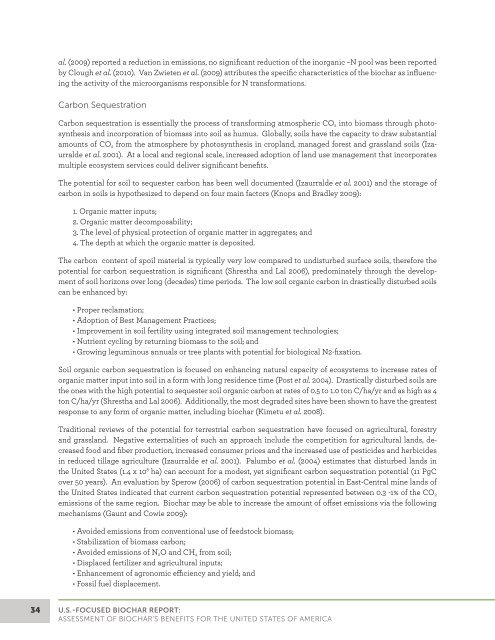U.S.-FocUSed Biochar report - BioEnergy Lists
U.S.-FocUSed Biochar report - BioEnergy Lists
U.S.-FocUSed Biochar report - BioEnergy Lists
You also want an ePaper? Increase the reach of your titles
YUMPU automatically turns print PDFs into web optimized ePapers that Google loves.
al. (2009) <strong>report</strong>ed a reduction in emissions, no significant reduction of the inorganic –N pool was been <strong>report</strong>edby Clough et al. (2010). Van Zwieten et al. (2009) attributes the specific characteristics of the biochar as influencingthe activity of the microorganisms responsible for N transformations.Carbon SequestrationCarbon sequestration is essentially the process of transforming atmospheric CO 2 into biomass through photosynthesisand incorporation of biomass into soil as humus. Globally, soils have the capacity to draw substantialamounts of CO 2 from the atmosphere by photosynthesis in cropland, managed forest and grassland soils (Izaurraldeet al. 2001). At a local and regional scale, increased adoption of land use management that incorporatesmultiple ecosystem services could deliver significant benefits.The potential for soil to sequester carbon has been well documented (Izaurralde et al. 2001) and the storage ofcarbon in soils is hypothesized to depend on four main factors (Knops and Bradley 2009):1. Organic matter inputs;2. Organic matter decomposability;3. The level of physical protection of organic matter in aggregates; and4. The depth at which the organic matter is deposited.The carbon content of spoil material is typically very low compared to undisturbed surface soils, therefore thepotential for carbon sequestration is significant (Shrestha and Lal 2006), predominately through the developmentof soil horizons over long (decades) time periods. The low soil organic carbon in drastically disturbed soilscan be enhanced by:• Proper reclamation;• Adoption of Best Management Practices;• Improvement in soil fertility using integrated soil management technologies;• Nutrient cycling by returning biomass to the soil; and• Growing leguminous annuals or tree plants with potential for biological N2-fixation.Soil organic carbon sequestration is focused on enhancing natural capacity of ecosystems to increase rates oforganic matter input into soil in a form with long residence time (Post et al. 2004). Drastically disturbed soils arethe ones with the high potential to sequester soil organic carbon at rates of 0.5 to 1.0 ton C/ha/yr and as high as 4ton C/ha/yr (Shrestha and Lal 2006). Additionally, the most degraded sites have been shown to have the greatestresponse to any form of organic matter, including biochar (Kimetu et al. 2008).Traditional reviews of the potential for terrestrial carbon sequestration have focused on agricultural, forestryand grassland. Negative externalities of such an approach include the competition for agricultural lands, decreasedfood and fiber production, increased consumer prices and the increased use of pesticides and herbicidesin reduced tillage agriculture (Izaurralde et al. 2001). Palumbo et al. (2004) estimates that disturbed lands inthe United States (1.4 x 10 8 ha) can account for a modest, yet significant carbon sequestration potential (11 PgCover 50 years). An evaluation by Sperow (2006) of carbon sequestration potential in East-Central mine lands ofthe United States indicated that current carbon sequestration potential represented between 0.3 -1% of the CO 2emissions of the same region. <strong>Biochar</strong> may be able to increase the amount of offset emissions via the followingmechanisms (Gaunt and Cowie 2009):• Avoided emissions from conventional use of feedstock biomass;• Stabilization of biomass carbon;• Avoided emissions of N 2 O and CH 4 from soil;• Displaced fertilizer and agricultural inputs;• Enhancement of agronomic efficiency and yield; and• Fossil fuel displacement.34U.S.-Focused <strong>Biochar</strong> Report:Assessment of <strong>Biochar</strong>’s Benefits for the United States of America
















